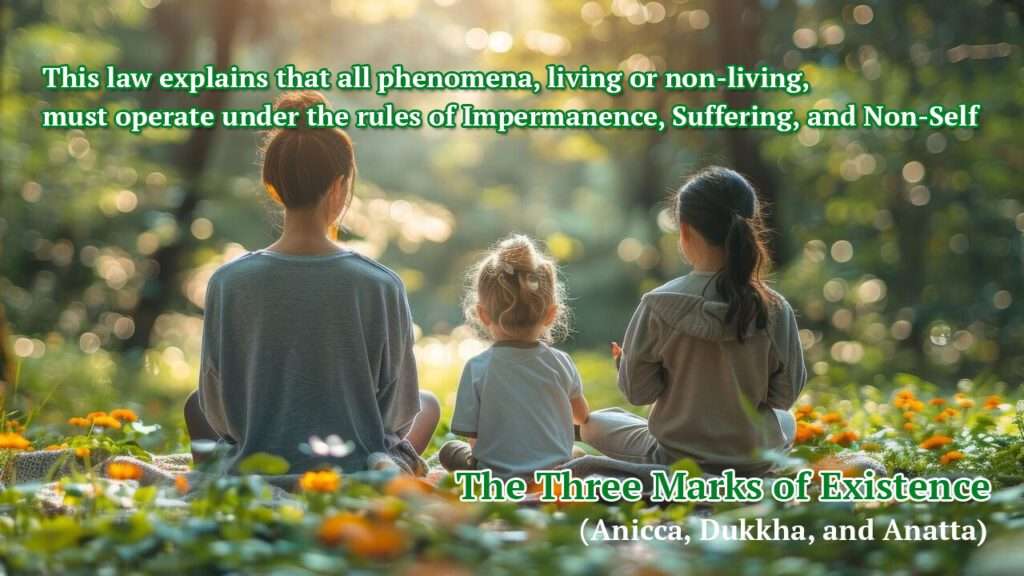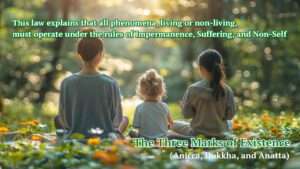Understanding The Three Marks of Existence (Anicca, Dukkha, Anatta)

The Three Marks of Existence is a crucial teaching within Buddhist Philosophy. It serves as the fundamental key to understand Buddha’s enlightenment. It represents the universal law applying to everything in the cosmos. This law explains that all phenomena, living or non-living, must operate under the rules of Anicca, Dukkha, and Anatta. Deeply understanding and accepting this reality is the only way to free ourselves from the suffering caused by clinging. This knowledge provides a powerful foundation for finding peace.
The Key to Genuine Happiness
Let us explore what each of The Three Marks of Existence means and how they manifest clearly in our daily lives.
1. Anicca (Impermanence) – The Mark of Change
Definition: Anicca means instability, variability, and uncertainty. Everything arises, remains for a time, and then ceases. Nothing can maintain its initial state indefinitely.
Real-Life Examples of Anicca:
- Physical Health:
- Today: Our bodies are energetic and strong.
- Tomorrow: The body naturally changes with age, experiencing illness, or reduced capability. We simply cannot command our cells to remain young forever. This is essential for Understanding Impermanence.
- Fashion and Technology:
- The expensive smartphone we buy today quickly becomes an older model within months.
- Current trends in fashion or music will inevitably be replaced by new popular styles.
- Emotions and Feelings:
- The happiness we feel at this moment cannot last eternally. Ultimately, it fades away and is replaced by other feelings, or simply by neutrality.
- Similarly, intense sadness or anger is just a visitor that must leave eventually.
2. Dukkha (Suffering/Dissatisfaction) – The Mark of Unsatisfactoriness
Definition: Dukkha signifies conflict, stress, and the state of being hard to endure. When the impermanent (Anicca) changes in an undesirable way, mental suffering immediately arises.
Real-Life Examples of Dukkha:
- Disappointment in Relationships (Viparinama Dukkha):
- We feel great joy in a healthy relationship (Happiness). When the relationship changes or ends (Anicca), the joy instantly turns into suffering.
- This Dukkha stems from clinging to impermanent happiness. This understanding is key for anyone seeking a Buddhist guide to letting go of attachment.
- Sense of Unfulfillment (Sankhara Dukkha):
- Even when living a comfortable, seemingly perfect life, we often feel a sense of boredom or emptiness.
- All conditioned things (Sankhara) have inherent imperfections. This compels us to constantly seek external fulfillment.
- The Burden of Maintenance:
- The effort required to maintain valuables, good looks, or power is a significant burden. This necessary upkeep inevitably causes stress and subtle suffering.
3. Anatta (Non-Self) – The Mark of Egolessness
Definition: Anatta means emptiness, the absence of a permanent true self (Atta). It cannot be controlled by will, and nothing possesses a true, lasting owner.
Real-Life Examples of Anatta:
- Attachment to Image and Identity:
- We strive to create the “Perfect Me“—successful, beautiful, and accepted by society.
- However, when criticized or judged, the elaborate “Self” we created shatters and crumbles. We cannot control the thoughts or perspectives of others.
- The Concept of Anatta clarifies that this “Self” is merely an image. It is built from fleeting perceptions and external factors that are beyond our control.
- Controlling the Body:
- We wish our bodies to be strong and never fall ill (Desire).
- Despite our best efforts, the body continues to age, weaken, and get sick naturally (Uncontrollable).
- Understanding Impermanence shows that the body is just a composition of elements governed by conditions. It is not fundamentally “ours” to command forever.

How to apply Three Marks of Existence in daily life
The aim of the Buddha’s teaching on The Three Marks of Existence is not to promote pessimism. Instead, it is to enable us to see the truth and stop clinging to things that must inevitably change.
When we accept that everything is subject to Anicca, Dukkha, and Anatta, we gain the ability to let go. We can then live peacefully in the present moment, free from the suffering of desiring permanence. This wisdom is the foundation of genuine inner peace.
Summary of the Core Teaching from the Anattalakkhana Sutta
Your summary perfectly captures the profound essence of the Three Marks of Existence. This Sutta guides us to live by accepting the reality of life (Yathābhūta-ñāṇadassana) in the following way:
- Seeing Reality (Anicca – Impermanence): We must accept that everything in life—possessions, our body, feelings, and relationships—is naturally subject to arising, persisting, and ceasing. Things can be gained and lost as an inevitable part of existence.
- Seeing Unsatisfactoriness (Dukkha – Suffering): We realize that because things are impermanent, they are inherently stressful (Dukkha). This stress arises when we are compelled to separate from what we love or face what we dislike. The desire to hold onto any moment of happiness forever is futile.
- Seeing Not-Self (Anatta – Egolessness): Since these things are impermanent and unsatisfactory, we should not cling to the idea that “This is mine” or “This is who I am.” There is no permanent, fixed self that we can truly control. (Do not be deluded into thinking that everything will stay with you forever.)
Practical Application in Daily Life: “Maintaining a Neutral Mind”
Enlightenment through the Three Marks does not mean abandoning the world. Instead, it leads to developing Equanimity (Upekkhā) or mindfulness of emotions, just as you described:
- When experiencing joy: Do not be swept away or cling to that happiness too much, knowing that it too will pass (Happiness is impermanent).
- When experiencing sorrow: Do not despair or become consumed by suffering, knowing that it, too, will eventually subside (Suffering is impermanent).
«From The Anattalakkhana Sutta (The Discourse on the Not-Self Characteristic)»
Follow us for more insider guides and updates on Thailand’s top destinations and experiences. @thaiimpact on x.com







